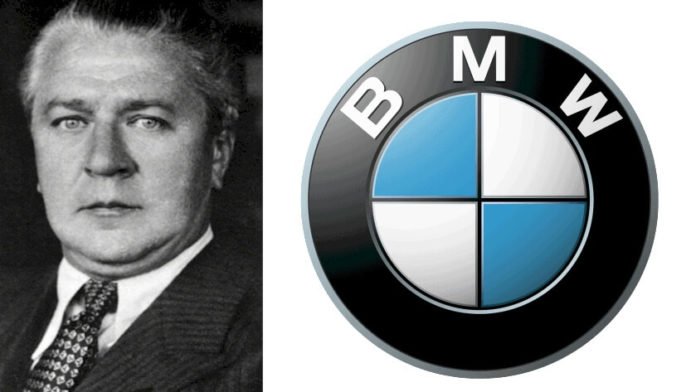This is a look at the BMW logo and some history behind the premium automobile.
Can you tell the number of cars the BMW Group sold in 2019? And do you know what accounted for those staggering figures? Well, the company sold nearly 2,520,357 vehicles which were boosted by the release of alternative models. Yet, there were other contributing factors.
BMW and the BMW logo is one of the world’s trusted brands because it offers customers exclusive and an unforgettable driving experience. A lustrous brand that combines speed, safety, and aesthetic vibes can’t be ignored by adventure–seeking clients. These are the other selling prowess.
The famous German automaker started producing aircraft engines for the Prussian army during World War I and II. Later, the company focused its energy on the making of cars and motorcycles. Today, the company is the brain behind Rolls Royce, Lamborghini, and others.
Since nothing can move without its shadow, the brand always comes with a unique logo. This iconic BMW emblem comprised a blue and white roundel in the middle of a white circular frame. Between the first and second frame is the brand’s name—BMW, boldly written at the top.
The white and blue color scheme of the BMW logo honors the birthplace of the brand, Bavaria. Due to state law, the colors were reversed to avoid breaching it. The celebrated logo is a mark of elegance, luxury, power, style, and wealth, and it’s everywhere.
The Evolution of BMW Logo
The BMW logo has gone through five transitional phases. These updates have met the demands of the time and hardly deviated from its charisma.
From the original logo to the current design, the BMW emblem looks similar. The famed logo derived its inspiration from the Rapp logo design in 1913. Together, let’s take a trip down memory lane to explore the various stages—beginning with the symbol that started it all.
1913 to 1917—The Rapp Logo
The maiden logo that represented the company as an aircraft engine maker was the Rapp logo design. It featured a silhouette horse in the center of a circular frame. The thick black frame also houses the brand’s name, two stars, and eight curved lines in white colors.
1917 to 1933—The Original BMW Logo
In 1917, the company unveiled its colorful BMW logo design. It featured four quadrants that looked like a roundel or aircraft propeller. These quadrants of two white colors and two blue colors sat in the middle of a thick black frame. The frame also comprised two thin gold outlines and the letters—BMW along its top.
1933 to 1953—The First BMW Logo Update
The company had its first redesign in 1933. Yet, the colors of its four quadrants in the middle of the frame remained the same. The two golden circular frames became thicker than the previous ones. Also, the brand’s name—BMW at the top became bolder, sharper, and sleeker.
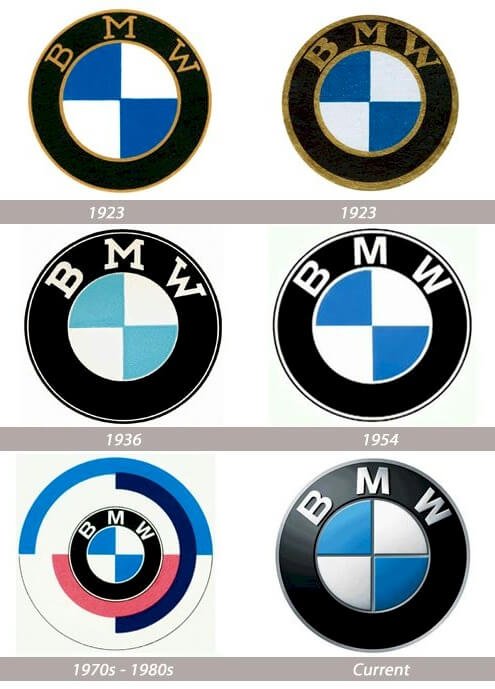
1953 to 1963—The Second BMW Logo Update
In 1953, another logo update took center stage. The designer chose thin silver outlines over the thick golden circular frames in the previous logo design. The letters—BMW, which had edges became gray, and the iconic blue and white roundel took on lighter shades. These changes made the black ring more visible, but the entire emblem boring.
1963 to 1997—The Third BMW Logo Update
In 1963, the redesign considered contrasting color effects—black, blue, and white. The circular frames and the wordmark—BMW became white on a black circular ring. The center blue and white quarters got intense. This logo design was clean, attractive, and spoke of authority and loyalty.
1997 to 2020—The Fourth BMW Logo Update
The 1997 BMW logo looked distinct, powerful, and modernized. It reflects the tech era! With a 3D appearance, the emblem featured a white wordmark on a broad circular background with silver–gray outlines. The inner blue and white quadrants became apparent due to black lines dividing them from both ends.
2020 to Now—The Fifth BMW Logo Update
After nearly three years, the company ignored the iconic 3D logo design for 2D. The designer replaced the dominant black frame with a thick white one. The brand’s name—BMW and the outlines went gray. The dividing lines between the quadrants also became invisible. So the logo looks clean, calm, powerful, and minimalist.
Why does the BMW Logo Works?
1. The BMW Logo Is Simple:
Customers admired the BMW logo because it’s simple. The logo design has no elaborate design elements to clutter its message. The logo is clean and noticeable, so people need little time to decode its message.
2. The Logo Is Attractive:
As humans, we love to associate with beautiful things. The modest blue and white emblem is well-balanced, attractive, and easy on the eye. Wherever it pops up, it’s visually inviting, so people admire it.
3. The Logo Is Memorable:
The BMW logo, like all iconic emblems, is memorable. With its clean layout and fewer graphic elements—circular frame, typeface, two colors, and quadrants, anyone can commit the visual symbol into memory.
4. The Logo Is Unique:
Most people know that the Rapp Logo inspired the BMW logo design. Yet, the two emblems are distinct from each other. In the branding world, there is no visual identity that resembles the BMW signature design. The logo is unique and above the competition.
5. The Logo Is Versatile:
To reach more customers, a logo must be versatile. The BMW logo can scale on any marketing medium with ease. This is because the logo has a modest layout, and it can fit any channel without losing its quality and shine.
The BMW Logo Design Elements

The founders and directors of BMW have shown their airplane and automobile design skills in their visual assets. With simplicity in mind, they choose colors, fonts, and shapes in the right blend to design a modest yet classic and powerful logo. Let’s explore the elements in details:
The BMW Symbol and Shape
1. Circles:
BMW seems addicted to circles. Circular frames have formed the core elements of its logo from the beginning till now. In graphic design, experts used circles to signify unity and infinity. As a sign of unity, it aligns with the family of loyal customers it serves. And as a mark of infinity, it signifies the company’s long existence—about 105 years.
2. Quadrants
Though discredited, the four quadrants formed a unique symbol that looks like an airplane propeller. This tale has a strong link to the brand’s heritage as an aircraft engine producer. From another insight, the blue and white inner quarters look like chess. It signifies the company directors’ strategic move to compete against other major players in the automobile industry.
The BMW Logo Colors:
Colors send non–verbal signals to people who understand their psychology. So, the BMW logo designer uses a few of them to evoke the personality of the brand. In brief, let’s examine three of the colors in the emblem below:
1. Black Color:
Automobile lovers who understand the emotions behind colors perceive the BMW brand as elegant, luxurious, and powerful. Why this perception? Because the color black evokes these feelings. Also, the color can mean simplicity, neutrality, and authority.
2. White Color:
On the BMW logo, the color white gives balance to the other colors—black and blue. The color evokes purity, cleanliness, and goodness. Also, white color can signify safety, wholeness, and virginity. It’s a superb choice of hue the designer used to give the logo negative space.
3. Blue Color:
Car buyers are looking for brands that can assure them of safety, reliability, and comfort. So BMW used the color of the sky to inform them it understands their fears. The color blue also stands for trust, calmness, and peacefulness.
What Font Is BMW Logo?
The BMW logo font has changed little from its beginning. The brand has used serif fonts with thin and thick lines in some of its logos. It has also used serif typefaces with notches. But the most prominent font is Helvetica, designed by Max Miedinger and Eduard Hoffmann in 1957.
Who Started BMW?
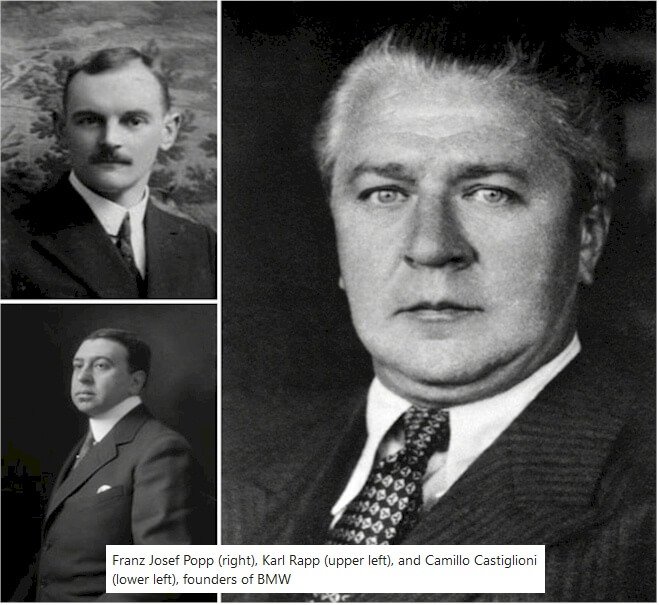
BMW is a global carmaker based in Munich, Bavaria in Germany. This trusted company that produces some of the finest automobile brands in the world owes its origin to three founders. Here we have Karl Rapp, Franz Josef Popp, and Camillo Castiglioni.
Karl Rapp was born on 24th September 1882 in Ehingen, Germany. He founded Rapp Motorenwerke, an aero-engine-making company. His company became BMW AG, and most people regard him as an indirect founder of BMW. He died on 26th May 1962.
On 14th January 1886, Franz Josef Popp was born in Vienna, Austria–Hungary. He was the first General Director for BMW AG from 1922 to 1942. He helped to build the foundation of the company. Franz died in Stuttgart, Germany, on 29th July 1954.
Next is Camillo Castiglioni. In Trieste, Austria–Hungary, he was born on 22nd October 1879. Camillo, regarded by many as an Italian–Austrian, was the richest man in Central Europe and BMW’s financier. He died on 18th December 1957 in Rome, Italy.
How Did BMW Begin?
Three separate entities—Rapp Motorenwerke, Bayerische Motorenwerke, and Fahrzeugfabrik Eisenach merged to become BMW. It all started in 1913 when Karl Friedrich Rapp began a company to focus on aircraft engine production.
The company produced airplane engines for the Prussian army, which ordered about 600 engines. But Karl Rapp was forced out of the company because of misunderstanding, and not long the company took on the name Bayerische Motorenwerke.
Interestingly, there was another company with a similar focus, and it was called Gustav Otto Flugmaschinenfabrik. Gustav Otto, a Bavarian pilot, formed it. The company suffered financial challenges and later sold. After the sales, the company became known as Bayerische Flugzeug–Werke (BFW). Later, it emerged with Bayerische Motorenwerke to become—BMW.
In 1918, the company made its first product, and it was named BMW IIIa. After World War I, the company made motorcycle engines and railway brakes because there was a ban on aircraft engines’ production. In 1923, BMW created its first motorcycle and named it R 32.
In 1928, BMW bought Fahrzeugfabrik Eisenach, and it branched into the production of cars. Most of its earliest cars were made at this plant in Thuringia, Germany. In 1929, a license from the Austin Motor Company paved the way for the maiden small BMW car to be made.
From 1933 onwards, aircraft production received substantial financial support from the German government. So, despite the production of motorcycles and cars, airplane engines’ production became the primary focus for BMW.
In 1935, the company produced about 10,000 units of motorcycles for that year. And by December 1938, BMW had reached 100,000 units of motorcycles per year. For the first time, the company engaged the services of an in–house doctor to take charge of health issues.
After World War II, part of the BMW plant was destroyed, and the remaining were banned from making either cars or motorcycles. But the company focused on producing pots, pans, and bicycles using second-hand materials for its items.
In 1947, BMW got the green–light to make motorcycles, and five years later, it began making cars. After the war, the first motorcycle made was the R 24, and the first car was BMW 501. The company expanded its models to include sports cars, sedans, convertibles, and coupes.
In the mid–1950s, the company position was awful. With short-term support from the government and Herbert Quandt increasing its shares, the company restructured. Under Herbert’s leadership, BMW released the 1500 model at the Frankfurt Motor Show in 1961.
The demand for this model exceeded supply, and it repositioned BWM as a powerful automobile maker in the industry. After this success story, there was no turning back for the company.
How Big Is BMW?
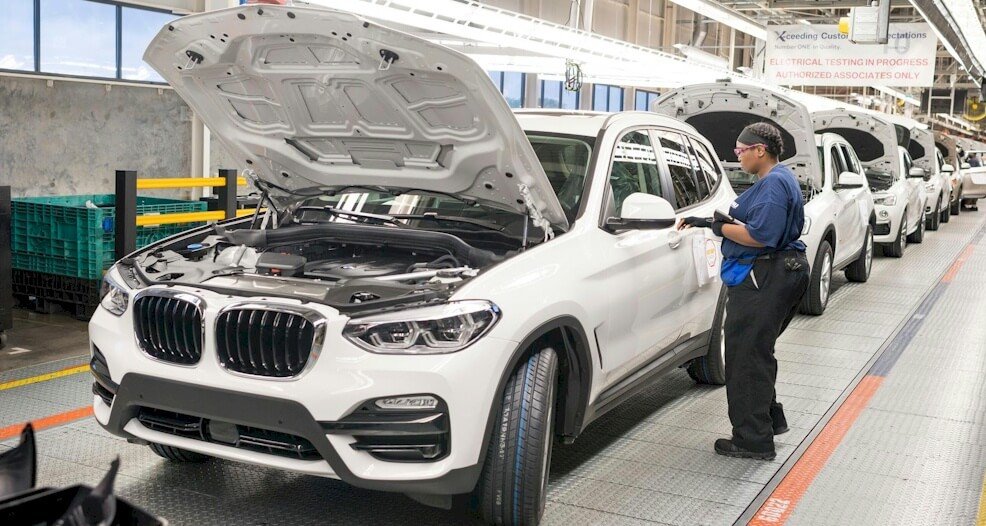
As an automobile company, BMW is one of the global brands that specialize in the production and sales of luxury and sports cars worldwide. It has thirty–one production and assembly facilities in fifteen countries. A few of these nations are Germany, Mexico, China, and the USA.
Some of its brands include BWM, MINI, and Roll–Royce. With these brands, the company becomes the world’s leading maker of premium cars. It has a global sales network in about 140 countries and a global workforce of nearly 126,016 staff as of December 2019.
The Statista Research Department report shows that BMW ranked as the 61st global brand with a value of about $20.5 billion in 2020. In 2019, the company’s production output was 2,564,025 cars—this production capacity brought revenue of €104.2 billion to the company.
What Does BMW Stands For?
The German automaker, which is popularly called BMW, is an acronym for Bayerische Motoren Werke. It traces its origin from Rapp Motoren Werke, a company noted for producing aircraft engines during World War I.
BMW, as a luxury car, resonates well with driving comfort. The letters—BMW also translates in English as the Bavaria Motor Works. The brand’s slogan is “The Ultimate Driving Machine,” and it showed up in North American in 1974.
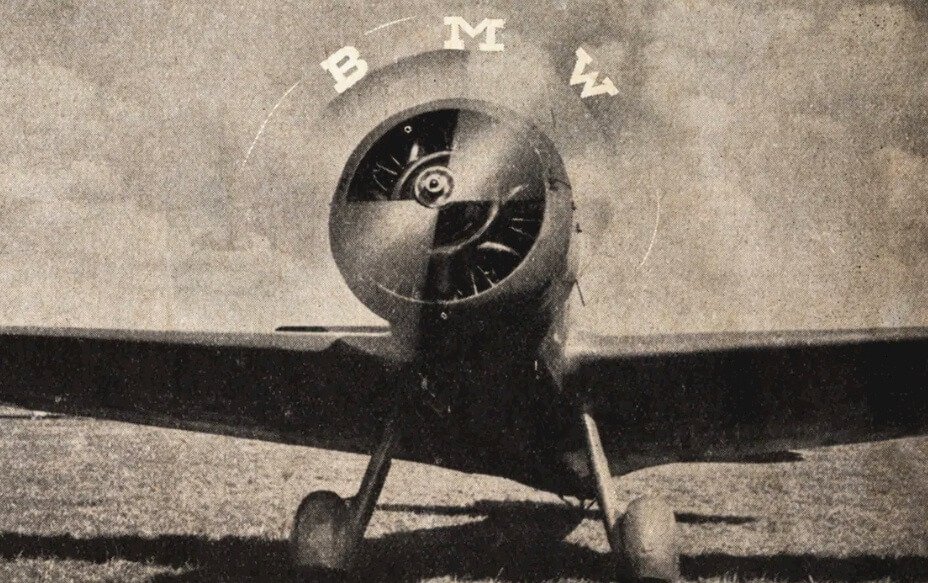
Who Owns BMW?
The BMW brands and series of premium models form the BMW Group. The German multinational carmaker is owned jointly by the public and the Quandt family. Together, the public shareholders own 50%, Stefan Quandt owns 29%, and Susanne Klatten owns 21%.
BMW Logo History In Summary
We value our lives—so it’s an inherent need for us to look for things that protect us from danger. The German automaker, BMW, for a century has lived up to the task. Otherwise, its loyal clients would have ditched it on another excellent brand. And it would have stayed–out of business.
The perceived value of safety, reliability, comfort, and the prestige that comes with owning a piece of its brands has catapulted it to everlasting glory. With its recent successes, we can assure ourselves that the company would keep writing its history in golden letters.
The roundel blue and white logo would continue to wheel the brand and its followers via the potholes to their respective destinations. Are we halting soon? And the emblem answered, “No, I’m driving y’all to another century avenue. Stay with me!”

